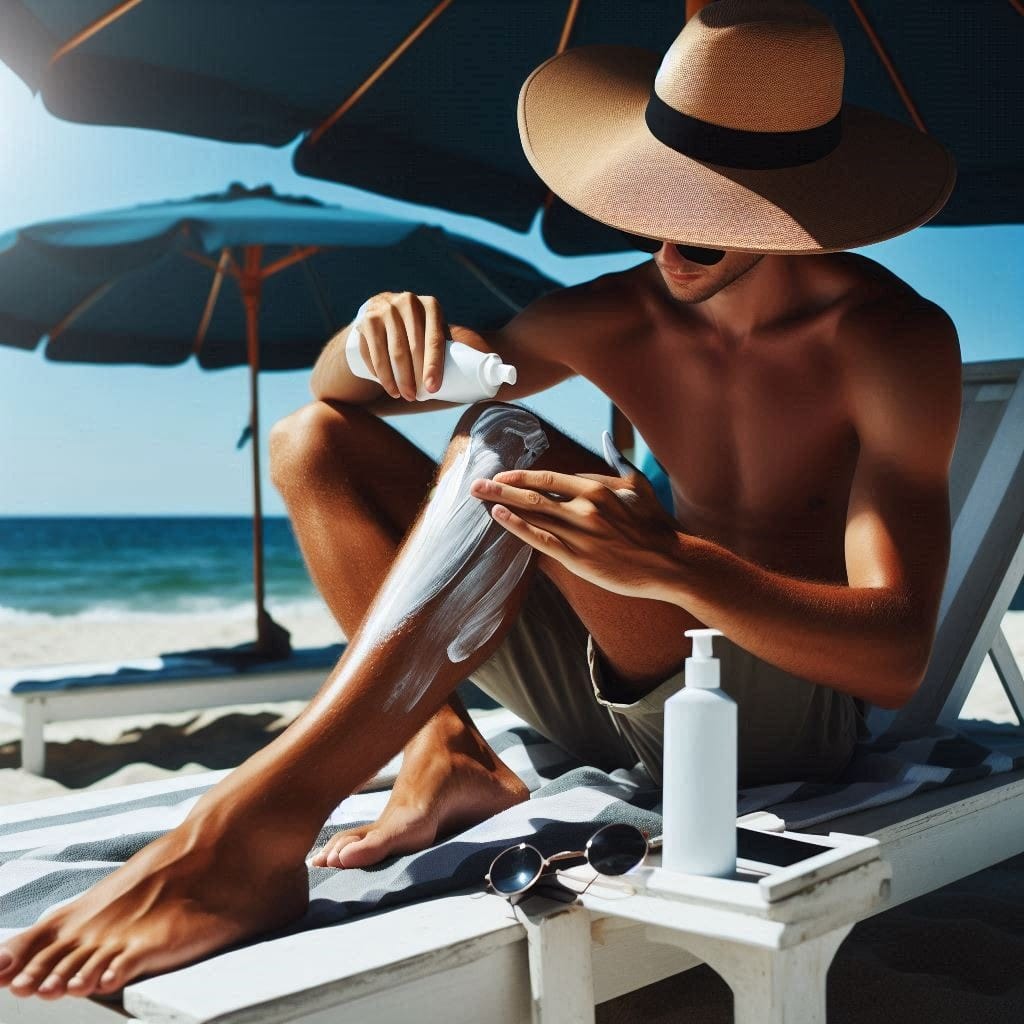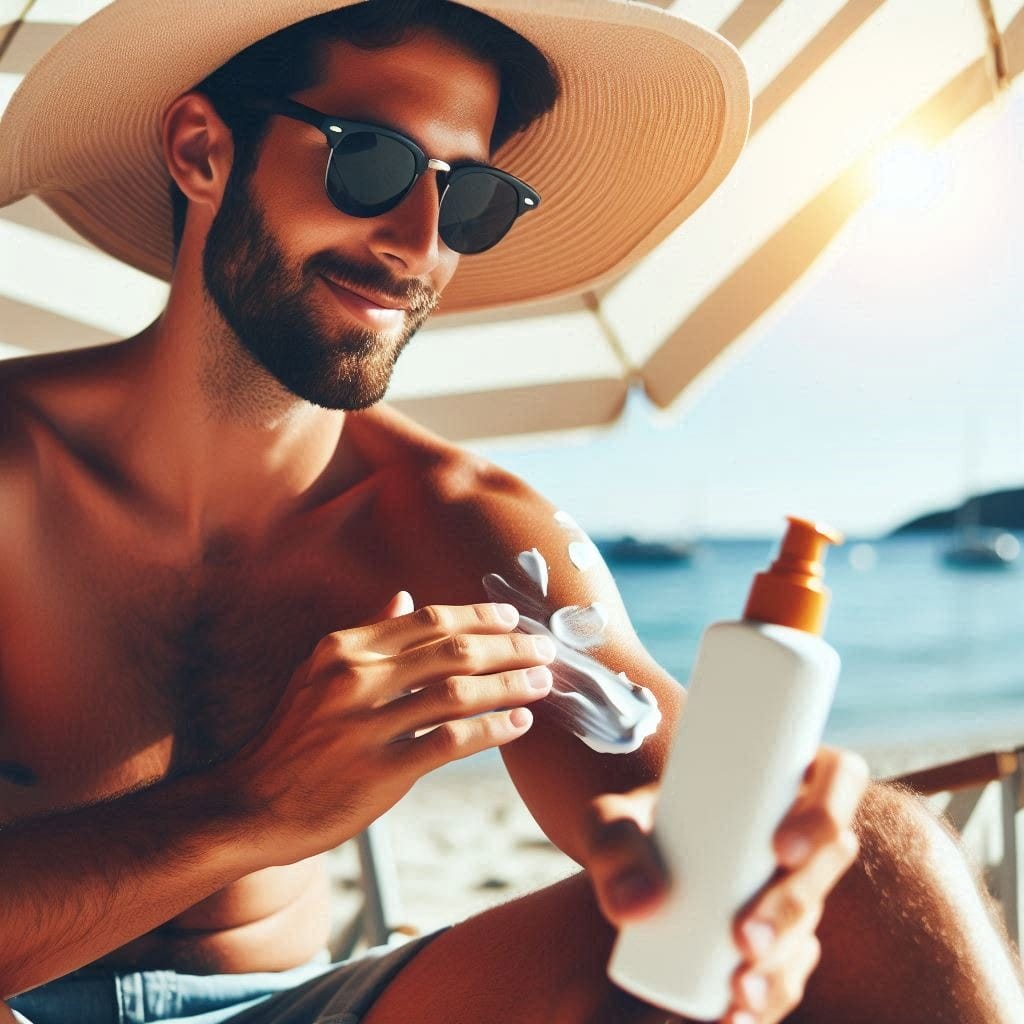As the weather warms up and the sun shines brighter, many of us are eager to soak up some sun. However, prolonged exposure to the sun’s harmful UV rays can often lead to painful sunburns. In this blog post, we will discuss some key tips on how to prevent and treat sunburns effectively. From avoiding peak sun hours and wearing protective clothing to using sunscreen with a high SPF and seeking shade when outdoors, there are plenty of ways to protect your skin. Additionally, staying hydrated, using soothing aloe vera or moisturizing lotion, and taking cool showers can help alleviate the discomfort of sunburns. We will also delve into some common questions about sunburns, such as how long they last, if they turn into tans, and the best ways to get rid of sunburn redness overnight. Join us as we explore the ins and outs of sunburn prevention and treatment to keep your skin healthy and happy all summer long. Protect your skin from sunburn with these expert tips: avoid peak hours, wear SPF 30+, seek shade, stay hydrated, and consult a dermatologist for severe burns.
Avoid sun exposure during peak hours
One of the best ways to protect your skin from sunburn is to avoid sun exposure during peak hours. This is typically between 10am and 4pm when the sun’s rays are the strongest. By staying indoors or seeking shade during these hours, you can significantly reduce your risk of getting a sunburn.
When you do need to be outside during peak hours, it’s important to wear protective clothing like hats and sunglasses. A wide-brimmed hat can shield your face and neck from the sun, while sunglasses can protect your eyes from harmful UV rays. Wearing long-sleeved shirts and long pants can also help protect your arms and legs.
In addition to wearing protective clothing, it’s crucial to apply sunscreen with SPF 30 or higher to any exposed skin. Be sure to cover all areas, including your face, ears, neck, and hands. Remember to reapply sunscreen every two hours, especially if you’re sweating or swimming.
If possible, try to seek shade when outdoors. This could be under a tree, umbrella, or awning. Taking breaks from the sun can give your skin a chance to cool down and prevent sunburn. Hydration is also key, so stay hydrated to prevent dehydration.
In the event that you do get a sunburn, there are a few remedies you can try. Using aloe vera or moisturizing lotion can help soothe the skin and reduce redness. Taking cool showers can also provide relief for sunburned skin. It’s best to avoid harsh skincare products that can further irritate the skin.
Wear protective clothing like hats and sunglasses
It is essential to prioritize your skin’s protection against harmful UV rays, especially during peak hours when the sun’s intensity is at its peak. One effective way to shield yourself from these rays is to wear protective clothing like hats and sunglasses. The brim of a hat can provide shade to your face, preventing direct exposure to the sun. Sunglasses with UV protection can also safeguard your eyes from potential damage caused by prolonged sun exposure.
Additionally, it is advisable to apply sunscreen with SPF 30 or higher on exposed skin areas to create an additional barrier against harmful UV rays. Remember to reapply sunscreen every two hours to maintain its effectiveness throughout the day. Seek shade whenever possible, especially during peak hours, to minimize direct exposure to the sun’s rays.
To keep your skin hydrated and prevent dehydration, make sure to stay hydrated by drinking plenty of water throughout the day. In case of sunburn, using aloe vera or moisturizing lotion can help soothe the skin and promote healing. Taking cool showers can also provide relief and alleviate any discomfort caused by sunburn.
As a preventive measure, it is important to avoid harsh skincare products
Apply sunscreen with SPF 30 or higher
When it comes to protecting your skin from harmful UV rays, applying sunscreen with SPF 30 or higher is crucial. Sunscreen acts as a barrier against the sun’s rays, reducing the risk of sunburn and skin damage.
By applying sunscreen with a higher SPF, you are providing your skin with better protection against both UVA and UVB rays. This means you are less likely to experience sunburn, premature aging, and skin cancer.
Make sure to apply sunscreen generously to all exposed areas of skin, including your face, neck, arms, and legs. Don’t forget to reapply sunscreen every two hours, especially if you are sweating or swimming.
Choosing a broad-spectrum sunscreen with SPF 30 or higher ensures that you are getting optimal protection from both UVA and UVB rays. This means you can enjoy time outdoors without worrying about damaging your skin.
Remember, sunscreen should be an essential part of your daily skincare routine, regardless of the time of year. By making sunscreen with SPF 30 or higher a priority, you are taking proactive steps to protect your skin from sun damage and keep it healthy and radiant.

Reapply sunscreen every two hours
It is crucial to reapply sunscreen every two hours to ensure maximum protection against harmful UV rays. Many people make the mistake of applying sunscreen only once before heading out for the day, but this is not enough to keep your skin safe from sunburn.
By reapplying sunscreen every two hours, you are replenishing the protection on your skin and reducing the risk of sun damage. This is especially important if you are spending extended periods of time outdoors or in direct sunlight.
Even if you are using a high SPF sunscreen, it can wear off due to sweat, water, or simply from being absorbed into the skin over time. To maintain effective protection, it is best to reapply sunscreen every two hours without fail.
Additionally, remember to reapply sunscreen after swimming or sweating, as water and sweat can reduce the effectiveness of the product. This simple step can go a long way in preventing sunburn and maintaining healthy skin.
Make it a habit to set reminders or carry a travel-size sunscreen with you so that you can easily reapply every two hours throughout the day. Your skin will thank you for the extra care and protection!
Seek shade when outdoors
When spending time outdoors in the sun, it is important to seek shade to protect your skin from harmful UV rays. Direct exposure to the sun’s rays can lead to sunburn and increase your risk of skin cancer.
Find a shady spot under a tree, umbrella, or awning to relax in when the sun is at its peak. This will help to prevent sunburn and keep you cool and comfortable.
Make sure to wear protective clothing like hats and sunglasses to further shield your skin and eyes from the sun. Wearing light, breathable clothing can also help to keep you cool while outdoors.
Remember to reapply sunscreen with SPF 30 or higher every two hours, especially if you are spending extended periods of time in the sun. This will provide an additional layer of protection for your skin.
By taking these precautions and seeking shade when outdoors, you can reduce your risk of sunburn and protect your skin from the sun’s harmful rays.
Stay hydrated to prevent dehydration
Staying hydrated is essential for your overall health, especially when you have a sunburn. Dehydration can worsen the symptoms of sunburn, making you feel more uncomfortable and prolonging the healing process.
One of the best ways to prevent dehydration is by drinking plenty of water throughout the day. Aim for at least eight glasses of water daily, and even more if you are spending time outdoors in the sun.
In addition to drinking water, you can also consume fruits and vegetables with high water content to help stay hydrated. Foods like watermelon, cucumbers, and oranges are great options to incorporate into your diet.
If you are experiencing severe dehydration due to sunburn, you may also consider drinking electrolyte-rich beverages like sports drinks or coconut water to replenish lost fluids and minerals.
Remember to listen to your body and drink water even before you feel thirsty, as thirst is a sign that you are already dehydrated. By staying hydrated, you can help alleviate the discomfort of sunburn and promote faster healing.

Use aloe vera or moisturizing lotion
One effective way to alleviate the discomfort of sunburn is to use aloe vera or moisturizing lotion. These products can help to soothe the skin and promote healing after sun exposure. It is important to apply them generously to affected areas, as they can provide much-needed relief.
Additionally, aloe vera has cooling properties that can help to reduce inflammation and redness associated with sunburn. It is a natural remedy that has been used for centuries to treat sunburn and other skin conditions.
Moisturizing lotions, on the other hand, can help to hydrate the skin and prevent it from drying out further. They can also help to reduce peeling and itchiness, which are common symptoms of sunburn.
When using aloe vera or moisturizing lotion to treat sunburn, it is important to continue application regularly until the skin has fully healed. This can help to speed up the healing process and minimize the long-term effects of sun damage on the skin.
Overall, using aloe vera or moisturizing lotion is a simple yet effective way to care for sunburned skin and promote healing. By following these tips, you can help your skin recover more quickly and avoid any further discomfort.
Take cool showers to soothe the skin
After a long day in the sun, nothing feels better than taking a cool shower to soothe your sunburned skin. The cool water helps to reduce inflammation and ease the burning sensation on your skin.
Make sure to avoid using hot water, as this can further irritate your sunburn. Instead, opt for lukewarm water to gently cleanse your skin and cool it down.
For added relief, you can add some oatmeal or baking soda to your bath water. These ingredients can help to calm and moisturize your sunburned skin, promoting healing and reducing discomfort.
After your shower, make sure to pat your skin dry gently with a soft towel. Avoid rubbing your skin, as this can further aggravate your sunburn and cause more pain.
Following up your cool shower with aloe vera or a moisturizing lotion can help to keep your skin hydrated and aid in the healing process. Remember to continue to drink plenty of water to stay hydrated from both the inside and out.
Avoid harsh skincare products
When it comes to taking care of your skin, it’s important to be mindful of the products you use. Harsh skincare products can do more harm than good, causing irritation, dryness, and even exacerbating sunburn. To avoid these issues, opt for gentle and mild skincare products that are suitable for your skin type.
Before purchasing any skincare product, make sure to read the labels and ingredients list carefully. Look for fragrance-free, alcohol-free, and non-comedogenic options to prevent any adverse reactions. Additionally, avoid products with harsh chemicals or artificial colors that can further irritate your sunburned skin.
Opt for soothing ingredients such as aloe vera, calendula, or oatmeal to help calm and hydrate your skin. These natural ingredients can provide relief from sunburn and promote healing without causing further damage.
Remember to be gentle with your skin when applying skincare products, especially if you have a sunburn. Avoid harsh scrubbing or rubbing, as this can further inflame your skin and delay the healing process. Instead, pat your skin dry and gently massage the product into your skin using soft and circular motions.
If your sunburn is severe or if you experience any unusual symptoms, it’s essential to consult a dermatologist for proper diagnosis and treatment. They can recommend specific skincare products or medications to help with the healing process and prevent any long-term damage to your skin.,

Consult a dermatologist for severe burns
When dealing with severe burns from sun exposure, it is crucial to seek professional help from a dermatologist. Severe sunburns can lead to blistering, swelling, and extreme pain, which may require medical treatment. Dermatologists are specialized in skincare and can provide the necessary care and treatment for severe burns.
Additionally, consulting a dermatologist for severe sunburns can help prevent long-term damage to the skin. They can assess the severity of the burn and recommend appropriate treatment options to promote healing and prevent infection.
It is important to seek medical attention if you experience severe symptoms such as intense pain, blistering, fever, or chills after sun exposure. These could be signs of a more serious burn that requires professional treatment.
Furthermore, dermatologists can provide advice on how to care for your skin after a severe sunburn to promote healing and prevent scarring. They may recommend specific skincare products or medications to help soothe the skin and reduce inflammation.
In conclusion, when faced with severe sunburns, consulting a dermatologist is essential for proper treatment and care. Their expertise can help alleviate pain, promote healing, and prevent long-term damage to the skin.
How to get rid of sunburn fast?
Sunburn can be a painful and uncomfortable experience, but there are several ways to help alleviate the symptoms and speed up the healing process. One of the first steps to take is to avoid sun exposure during peak hours, typically between 10am and 4pm, when the sun’s rays are the strongest and most damaging to the skin.
Wearing protective clothing such as hats and sunglasses can also help shield your skin from harmful UV rays. Additionally, applying sunscreen with SPF 30 or higher before going outside can provide an extra layer of protection against sunburn.
It is important to reapply sunscreen every two hours or after swimming or sweating to ensure continuous coverage. Seeking shade when outdoors can also help reduce your risk of sunburn and prevent further damage to the skin.
Staying hydrated by drinking plenty of water is essential to prevent dehydration, which can worsen the symptoms of sunburn. Using aloe vera or a moisturizing lotion can help soothe and hydrate the skin, promoting healing and relieving discomfort.
In severe cases of sunburn, it is recommended to consult a dermatologist for treatment options. They may prescribe medication or recommend specialized care to help alleviate the symptoms and accelerate the healing process.
How do you get rid of sunburn redness overnight?
Sunburn redness can be extremely uncomfortable and unsightly, especially if you have an event or outing coming up. To help alleviate redness overnight, consider using aloe vera gel as a natural remedy. Applying a thin layer of aloe vera to the affected area can help soothe the skin and reduce inflammation. Alternatively, you can use a moisturizing lotion with calming ingredients like cucumber or chamomile to provide relief.
If the redness is particularly severe, you may also want to consider applying a cold compress to the affected area. This can help constrict blood vessels and reduce swelling, providing immediate relief from the discomfort of sunburn redness. Additionally, consider taking an over-the-counter anti-inflammatory medication like ibuprofen to help reduce redness and inflammation from the inside out.
Another tip to help get rid of sun burn redness overnight is to stay hydrated. Drinking plenty of water can help flush toxins from your body and keep your skin hydrated, which can promote faster healing. Avoiding alcohol and caffeinated beverages can also help prevent further dehydration and irritation.
In addition to these remedies, you may want to consider using a green-tinted concealer to help minimize the appearance of redness on your skin. Green color correctors can help counteract the red tones of sunburn, providing a more even complexion. Just make sure to blend the concealer well to achieve a natural-looking finish.
Remember, everyone’s skin reacts differently to sun burn remedies, so it may take some trial and error to find the best solution for your specific needs. If you experience severe pain, blistering, or peeling skin, it’s important to see a dermatologist for professional treatment. Taking care of your skin and protecting it from the sun in the future can help prevent future bouts of sunburn redness.
How long do sunburns last?
Sunburns can vary in duration depending on the severity of the burn. Mild sunburns typically last for about 3 to 5 days. During this time, the skin may appear red, feel hot to the touch, and potentially peel once the burn starts to heal.
However, moderate sunburns can last for up to a week or longer. In addition to redness and peeling, moderate sunburns may also cause swelling, blistering, and intense pain. It is important to keep the affected area moisturized and protected from further sun exposure during the healing process.
Severe sunburns, on the other hand, can last for weeks or even months. These burns are characterized by extreme pain, deep redness, swelling, and possible infection. Severe sunburns may require medical treatment to prevent long-term damage to the skin.
Regardless of the severity of the sun burn, it is crucial to avoid exposing the affected area to the sun until it has fully healed. This can help prevent further damage and speed up the healing process.
If you experience severe symptoms such as fever, chills, nausea, or widespread blistering, it is important to seek medical attention immediately. A healthcare provider can assess the severity of the burn and recommend appropriate treatment to promote healing and prevent complications.
Do sunburns turn into tans?
Sunburns are a common consequence of spending too much time in the sun without proper protection. When the skin is exposed to ultraviolet (UV) rays for an extended period, it can become inflamed and painful, resulting in a red or pink coloration. While sunburned skin will eventually heal and return to its normal color, many people wonder whether sunburns can actually turn into tans.
Contrary to popular belief, sunburns do not turn into tans. Sunburn is actually the skin’s way of trying to repair damage caused by UV rays. When the skin is exposed to excessive sunlight, it produces more melanin, the pigment responsible for tanning. However, this melanin production is not enough to protect the skin from further damage, so the skin becomes red and inflamed instead.
Although a tan may develop after the sunburn fades, it is important to remember that any change in skin coloration is a result of sun damage. Tans are not a sign of healthy skin, but rather an indication that the skin has been exposed to harmful UV radiation. In fact, tans are actually a defense mechanism that the skin uses to protect itself from further damage.
To prevent sun burn and tans, it is essential to protect your skin from UV rays by wearing sunscreen, seeking shade, and avoiding peak sun exposure hours. If you do get sunburned, it is important to treat your skin with care and avoid peeling or picking at it. Remember that the best way to achieve a safe, healthy tan is through gradual exposure to sunlight and proper sun protection.
In conclusion, sunburns do not turn into tans. While a tan may develop after a sunburn, it is important to remember that any change in skin coloration is a result of sun damage. To protect your skin and prevent sunburns, be sure to follow sun safety tips and take care of your skin with proper skincare routines.
Does drinking water help sunburn?
Drinking plenty of water is essential when dealing with sunburn. Dehydration can worsen the symptoms of sunburn, so it is important to stay hydrated by consuming ample amounts of water throughout the day.
When the skin is damaged from sun exposure, it can become dry and flaky. Drinking water helps to moisturize the skin from within, promoting faster healing and reducing peeling.
In addition to hydrating the skin, water also helps to flush out toxins from the body, aiding in the recovery process from sunburn. This can help to reduce inflammation and promote overall skin health.
While drinking water is not a cure for sunburn, it can help to alleviate some of the discomfort and promote healing. It is important to continue to drink water regularly, along with other soothing remedies, to help your skin recover from sunburn.
So, the next time you experience a sunburn, make sure to reach for a glass of water to help your skin heal and recover more quickly.
How to sleep with a sunburn?
Sunburns can be painful and uncomfortable, especially when it comes time to try and get some sleep. Here are some tips on how to sleep with a sunburn:
Avoid sleeping on your stomach or back, as these positions can put pressure on the sunburned areas. Instead, try sleeping on your side to relieve some of this pressure.
Use cool, damp cloths or ice packs to help soothe the burn before bed. This can help reduce swelling and discomfort, making it easier to fall asleep.
Wear loose, breathable clothing to bed to avoid further irritation of the sunburn. Cotton fabrics are a good choice, as they are gentle on the skin and allow for air circulation.
Consider taking an over-the-counter pain reliever before bed to help manage any discomfort you may be experiencing. This can help you relax and drift off to sleep more easily.
What pulls heat out of sunburn?
Sunburn can be a painful experience that can leave your skin feeling hot and irritated. There are a few ways to help pull the heat out of a sunburn to provide relief.
One method to pull heat out of sun burn is by taking a cool shower. The cool water can help soothe the skin and lower the temperature of the burned area. Make sure the water is not too cold, as this can further irritate the skin.
Another way to pull heat out of sun burn is by applying aloe vera or a moisturizing lotion to the affected area. Aloe vera has anti-inflammatory properties that can help reduce redness and swelling, while moisturizing lotions can help hydrate and cool the skin.
Drinking plenty of water can also help pull heat out of sunburn. Staying hydrated can prevent dehydration, which can make sunburn symptoms worse. Water can help cool the body from the inside out and promote healing.
Seeking shade when outdoors and wearing protective clothing like hats and sunglasses can also help prevent sunburn and reduce heat exposure. It’s important to take precautions to avoid sunburn in the first place, but these tips can help provide relief if you do end up with a sunburn.
Frequently Asked Questions
What are the best ways to prevent sunburn?
Some of the best ways to prevent sunburn include wearing sunscreen, protective clothing, seeking shade, and avoiding peak sun hours.
How often should I reapply sunscreen to avoid sunburn?
Sunscreen should be reapplied every 2 hours, or more frequently if swimming or sweating.
What are the symptoms of sun burn?
Symptoms of sun burn include redness, pain, blistering, and peeling of the skin.
Is it possible to get sun burn on a cloudy day?
Yes, it is still possible to get sunburn on a cloudy day as up to 80% of the sun’s UV rays can penetrate through clouds.
How can I treat sun burn at home?
To treat sun burn at home, you can take a cool bath or shower, apply moisturizer, drink plenty of water, and take over-the-counter pain relievers.
When should I seek medical help for sun burn?
You should seek medical help for sun burn if you experience severe blistering, fever, chills, or signs of infection.
Can sunburn increase the risk of skin cancer?
Yes, repeated sun burns can increase the risk of skin cancer, so it’s important to protect your skin from the sun.
